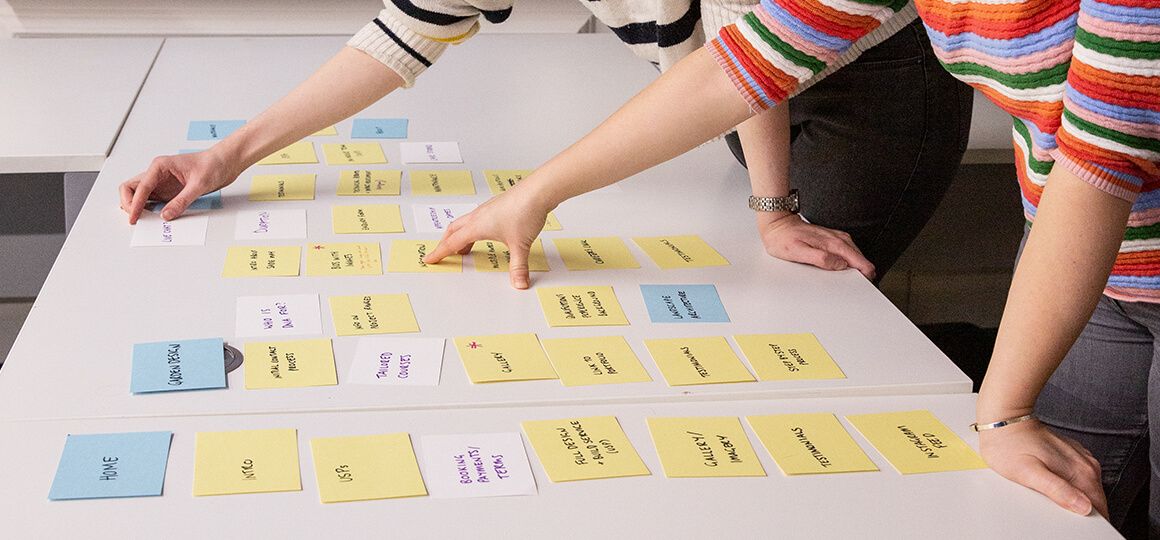UX testing is absolutely essential to a successful website.
But there's no point leaving all your testing to the end of a project, you need to use the right usability testing methods at every stage.
That's how you know you're making good decisions right from the outset, and know how to grow the site in the future too.
So here are our favourite UX tests, split into groups for the best tests for your planning and strategy, design and build, and finishing up and ongoing work.
Stuff to start with
- Surveys
- Carding
- Tree Testing
Whilst you're working
- First Click Testing
- 5 Second Testing
- Heatmaps
- Keystroke Levels
Finishing and future
- A/B Testing
- Guerilla Testing
- Lab Testing
In this article we're not solely focusing on UX design tests, but the whole landscape of user experience, including content, design, functionality and marketing.
Surveys
Starting off your project with a survey is particularly useful if you're doing a redesign or redevelopment of a current website.
It's one of the simplest user research methods you can use. By asking some questions up front, you can identify what's already working with the site you already have.
You can also find out what might motivate a user to do more, use the site more regularly or spend more money.
If you're running an online survey, it's an easy way to get responses when users are actually on site and interacting, and you can even send it out by email to select focus groups too.
Card sorting
Card sorting is where you write index cards for all the content sections you want on your site, and arrange them into a sitemap and page structure.
It's a great way to scope out all the text you're going to need, as well as rough user journeys.
To really make the most of carding as a UX research method, combine it with tree testing for a really thorough test.
Tree Testing
Once you've got your sitemap or carding structure, tree testing is a simple way to see if it's going to be easy to navigate for users.
All you do is ask people to find something in the hierarchy.
If they can quickly point to the section or page where they expect to find that content, it's working.
If not, you may need to think about a reworking of the information architecture, or some more helpful CTAs to point users in the right direction.
First Click Testing
First click testing works best when you have an interactive wireframe, home page or landing page concepts to play with.
It's similar to tree testing, where users are asked where they'd click first to find certain information or start a process.
Testers should be able to find the right first click almost instantly.
If they're having usability problems, you might want to look at the layout and hierarchy of content sections, or even the UX writing for your page names or CTAs.
If you want to learn a little more about UX writing and how it can help boost the usability of your website, have a look to our definitive guide to UX writing.
5 Second Test
The 5 second test is an ideal testing process for design concepts, as it gives you feedback on people's first impressions of a site.
Test participants get a 5 second look at a page, and afterwards are asked a single question about it.
That question might be "who do you think the target audience is for this site?".
It might be "would you trust this site?".
The biggest complexity for this type of user experience testing is coming up with the right question to ask.
It should be informed by your planning phase and what the main motivators and pain points are for your users.
That will give your design team feedback that actually measures the success of your design in appealing to your audience.
Heatmaps
Heatmaps are a great tool once you've got an interactive wireframe, or a fully built site to play with.
Installing heatmap software allows you to track users as they use the website.
Not only do you see what pages they're on, but you can see mouse movements, clicks and interactions on the page too.
All information is anonymised, so you can't see what details are put into forms or anything like that.
But this level of detail can show you much more about how someone is using the site, and flag up any recurring issues.
Heatmapping is a really useful UX tool long after your site is built and launched too.
You can continue to use it to keep up to date with how users are interacting with your site, as well as how successful any new updates are.
Keystroke levels
This is one of the few UX tests that we advise you always do in-house with one of the development team, and NOT with the general public or an external tester.
That's because a keystroke level test is where you measure the time and count the clicks it takes to complete an action on your site.
For example, how long does it take to find a product and buy it.
This is about the raw data of how long something should take. The benchmark for how fast it should be.
If a process is too long even for the most experienced user, you know it will need streamlining.
A/B testing
Some people don't consider A/B tests to be UX testing, but I disagree.
A/B tests are where you have two versions of a page or site, with one element changed between them. It could be anything from the header image to the CTAs and anchor text.
Users are split between the two versions, and you track how they interact with each one, and see which is more successful.
It's really important that there's only one significant change between the two options, as otherwise you'll be stuck trying to work out which changed element was the trigger for users' decisions.
This sort of test is mostly used for landing pages, and often it's for marketing campaigns after a site has launched, but can still be useful earlier in the process.
Guerilla Testing
Getting users to do UX testing on the site either pre or post launch, can really help you iron out any kinks.
Guerilla or remote testing sets up tasks for a tester to complete on the site, with the session recorded so it can be watched back by the team.
This sort of UX testing can be really useful before or just after a site launches, but can also be really helpful to test out the success of new features, or A/B tests.
Lab Testing
Once you've got a fully built website, whether it's live or not, lab testing is the best and most in-depth method of user testing.
It will give you feedback on the user interface, look and feel of the website, and even the products or services in general. It's really the most all-encompassing user experience research you can do.
In a lab test, you come up with several scenarios for a user on the site, as well as some general questions, and invite testers to come in and complete tasks alongside a moderator.
Having the moderator there is really important. They'll not only be able to guide the tester where necessary, they'll also be able to ask questions about their thought process as they use the site.
That's something you can't get from recorded user sessions, surveys or pretty much any other kind of UX test.
Recording the audio and visuals for these sessions is also really helpful, as you can watch it back with the design, dev and UX teams.
Lab testing is a bit more intensive than a remote usability test, and does need a lot more input from the team. But it goes into much more depth too, so it's worth the time and investment.
What's right for you?
Picking the right UX tests for your project depends on your process, the type of project you're working on, and also how much you want and need to invest in the UX experience.
This guide provides a good outline of some of the best UX testing methods, as well as when you can use them, and how they work.
I hope it's given you a good idea of how to approach UX testing for your project, and if you want to find out more about UX in general, why not have a read of our in-depth UX Guide for beginners?



